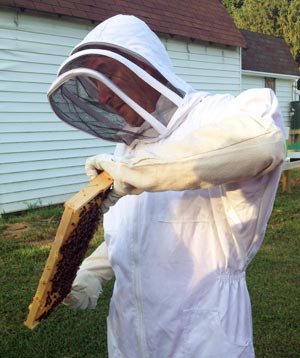Bringing Back the Bees
Gardeners and others are joining a broad new effort to replenish the nation’s hard-hit bee population.

As bee populations dwindle further, to hardly more than half their numbers in the early 1970s, a new save-the-bees offensive is under way.
Bees, along with other pollinators, are critical to producing crops — apples, almonds, avocados, melons, cranberries, to name just a few — valued at $20 billion a year. But bees have been decimated in recent years by pesticides, drought, stress and varroa mites — the scourge of honeybees everywhere.
Now, beekeepers, conservationists, gardeners, and public and private agencies are joining together to bolster bee habitats and diets in hopes of making honeybees and wild bees thrive once again.
From just $107.88 $24.99 for Kiplinger Personal Finance
Become a smarter, better informed investor. Subscribe from just $107.88 $24.99, plus get up to 4 Special Issues

Sign up for Kiplinger’s Free Newsletters
Profit and prosper with the best of expert advice on investing, taxes, retirement, personal finance and more - straight to your e-mail.
Profit and prosper with the best of expert advice - straight to your e-mail.
Moreover, entomologists are enlisting help from honeybees abroad to reinvigorate their cousins in North America. A team from Washington State University is impregnating queen bees in the U.S. with sperm collected from drones in Europe.
Sperm taken from an Italian strain of honeybees, which reproduce faster than most other honeybees, will benefit farmers who need as many bees as possible to pollinate their orchards. Sperm from cold-tolerant bees native to the Alps and Caucasus Mountains will help American bees avoid being decimated by late spring freezes. That hardiness will also lessen hive infestations by varroa mites — the scourge of honeybees everywhere.
Meanwhile, repopulation efforts are rapidly gaining steam at the federal and state levels as well as in the private sector.
Federal initiatives: The Department of Agriculture is making the creation of bee-friendly environments a key to obtaining contracts and cost-sharing grants under the Environmental Quality Incentives Program.
Further, 100,000 acres enrolled in Uncle Sam’s Conservation Reserve Program are now committed to favorable types of habitats for pollinators. In fact, farmers are eligible for $150 bonuses on new CRP enrollments featuring bee habitats that have been reviewed and approved by the government.
In the states: A number of initiatives are under way. A bill pending in Minnesota, for example, calls for the creation of a list of suitable plants for bee habitats and orders such vegetation to be included in the state’s conservation easements.
West Virginia’s Commissioner of Agriculture Walt Helmick has mining companies promising to start seeding bee habitat next spring on lands reclaimed from coal mining. They’ll also ensure that beekeepers have access to those lands. State road and forestry crews will place bee-friendly plants along roads and in forests. The state department of transportation, for example, will “plant clover in the I-64 right-of-way from the Kentucky line west to Huntington. That’s 20 miles of clover,” Helmick says.

The private sector: The plight of bees is garnering sympathy among growing numbers of Americans, who are planting flowers and other plants that can feed bees year-round.
There’s a huge new interest in beekeeping, too, throughout the country. Countless gardeners, farmers and others are taking up beekeeping as a hobby, helping to foster community awareness and protective attitudes toward bees.
“The best single thing that’s happened for bees is the tremendous increase in beekeeping,” says Don Hopkins, North Carolina’s apiary inspection supervisor. Membership in the Tar Heel State’s beekeepers’ association has more than doubled, to 4,000 members, in just the past two years, he says, noting that represents just a fraction of the state’s beekeepers overall.
Nationally, the American Beekeeping Federation says its membership is poised to hit 1,300, a 50% increase in four years.
Workshops on creating pollinator habitats are becoming commonplace. The Native Pollinators in Agriculture Project, an effort launched by the National Association of State Conservation Agencies, will hold a field training session in October in Massachusetts. It will focus on teaching cranberry growers and other farmers about what sorts of vegetation to plant along cranberry bogs to provide quality nutrition for bees throughout cranberry season. A similar session will be held in Michigan in December for growers in the Great Lakes region.
To further protect bees, the Environmental Protection Agency is banning the use of certain insecticides when pollinators are gathering nectar and pollen. Insecticide manufacturers have until Sept. 30 to make label changes to these pesticides, warning farmers and others of the restrictions. The pesticide makers must also inform the EPA of their pollinator stewardship plans: steps taken to ensure that farmers and other applicators avoid killing any bees.
Profit and prosper with the best of Kiplinger's advice on investing, taxes, retirement, personal finance and much more. Delivered daily. Enter your email in the box and click Sign Me Up.

-
 Your Guide to Buying Art Online
Your Guide to Buying Art OnlineFrom virtual galleries to social media platforms, the internet offers plenty of places to shop for paintings, sculptures and other artwork without breaking the bank.
-
 Samsung Galaxy S25 Ultra for $4.99 a Month: A Closer Look at Verizon’s Deal
Samsung Galaxy S25 Ultra for $4.99 a Month: A Closer Look at Verizon’s DealVerizon’s aggressive pricing makes Samsung’s top-tier phone tempting, but the real cost depends on your plan and how long you stay.
-
 I'm 59 with $1.7 million saved and lost my job. Should I retire?
I'm 59 with $1.7 million saved and lost my job. Should I retire?We asked professional wealth planners for advice.
-
 Disney’s Risky Acceptance of AI Videos
Disney’s Risky Acceptance of AI VideosThe Kiplinger Letter Disney will let fans run wild with AI-generated videos of its top characters. The move highlights the uneasy partnership between AI companies and Hollywood.
-
 AI Appliances Aren’t Exciting Buyers…Yet
AI Appliances Aren’t Exciting Buyers…YetThe Kiplinger Letter Artificial intelligence is being embedded into all sorts of appliances. Now sellers need to get customers to care about AI-powered laundry.
-
 What to Expect from the Global Economy in 2026
What to Expect from the Global Economy in 2026The Kiplinger Letter Economic growth across the globe will be highly uneven, with some major economies accelerating while others hit the brakes.
-
 The AI Boom Will Lift IT Spending Next Year
The AI Boom Will Lift IT Spending Next YearThe Kiplinger Letter 2026 will be one of strongest years for the IT industry since the PC boom and early days of the Web in the mid-1990s.
-
 Amid Mounting Uncertainty: Five Forecasts About AI
Amid Mounting Uncertainty: Five Forecasts About AIThe Kiplinger Letter With the risk of overspending on AI data centers hotly debated, here are some forecasts about AI that we can make with some confidence.
-
 Worried About an AI Bubble? Here’s What You Need to Know
Worried About an AI Bubble? Here’s What You Need to KnowThe Kiplinger Letter Though AI is a transformative technology, it’s worth paying attention to the rising economic and financial risks. Here’s some guidance to navigate AI’s future.
-
 Will AI Videos Disrupt Social Media?
Will AI Videos Disrupt Social Media?The Kiplinger Letter With the introduction of OpenAI’s new AI social media app, Sora, the internet is about to be flooded with startling AI-generated videos.
-
 What Services Are Open During the Government Shutdown?
What Services Are Open During the Government Shutdown?The Kiplinger Letter As the shutdown drags on, many basic federal services will increasingly be affected.